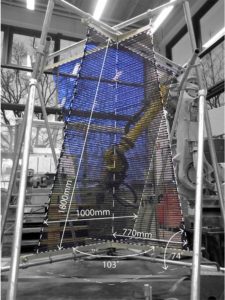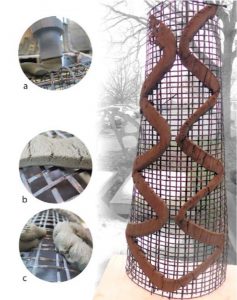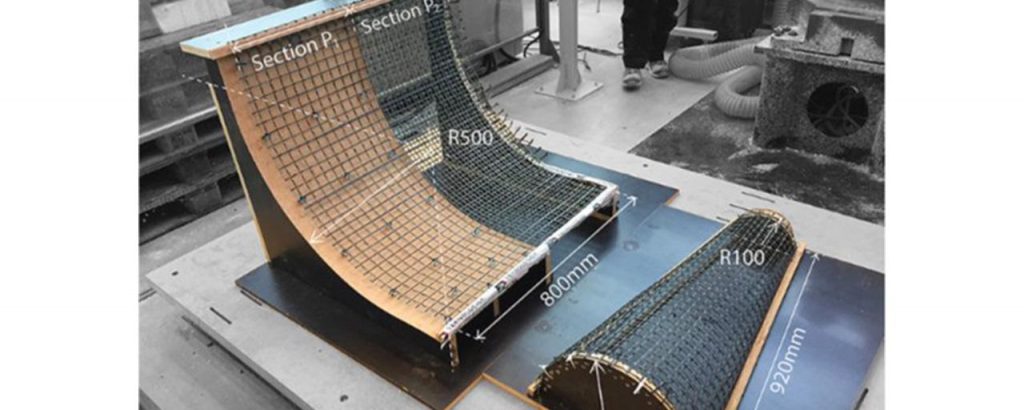3D printed construction is a growing field, with new methods being developed on a regular basis. The latest comes from the Centre for Information Technology and Architecture (CITA) of the Royal Danish Academy of Fine Arts and the Danish Technological Institute, where researchers have developed a new hybrid construction concept called Sparse Concrete Reinforcement in Meshworks, or SCRIM. The method addresses limitations in current concrete 3D printing, such as the printing of non-extruded geometries, and allows for full exploitation of six-axis robotic control. It also focuses on the manufacturing of lightweight components.
 Details about the new technology can be found in a paper entitled “SCRIM — Sparse Concrete Reinforcement in Meshworks.”
Details about the new technology can be found in a paper entitled “SCRIM — Sparse Concrete Reinforcement in Meshworks.”
“This research has resulted from a collaboration between CITA and the Concrete Centre at DTI,” Phil Ayres and Wilson Ricardo Leal da Silva, two of the researchers who carried out the study, told TechXplore. “DTI invited CITA to participate in a brainstorming workshop to consider how we might rethink approaches to 3D concrete printing (3DCP) in the context of ‘Design for Disassembly.’ The brief was immediately challenging to prevalent 3DCP approaches, which tend to print a ‘whole’—this is where we envisioned the idea behind the SCRIM method.”
SCRIM is different from other methods of 3D printed concrete construction, which typically extrude layers of material to build up vertically, resulting in a few limitations on geometry and incorporation of reinforcement.
“Conventional 3DCP approaches generally stack material vertically and have challenges with the incorporation of reinforcement and other architectural elements,” Leal da Silva said. “In contrast to the stacking approach, the SCRIM concept employs carbon-fibre-reinforced polymer (CFRP) meshes that are printed upon directly.”
 SCRIM arranges meshes into target geometries, which can include vertical areas. Concrete is selectively deposited into the mesh, which keeps the material in place and acts as a reinforcement.
SCRIM arranges meshes into target geometries, which can include vertical areas. Concrete is selectively deposited into the mesh, which keeps the material in place and acts as a reinforcement.
“Conceptually, we can think of the method as locally reinforcing a textile membrane with concrete, rather than monolithic printing, which underlies existing approaches,” Ayres said.
SCRIM also allows for the addition of elements or embellishments and supports complex geometries, giving designers greater freedom.
“There are still challenges to be solved in 3DCP, but the SCRIM method contributes to diversifying the existing spectrum of digital construction approaches in a field that is being heavily explored in the research community. A key difference is that SCRIM fully engages the 3D control and movement capabilities of six-axis robotics,” Ayres said. “From a design perspective, this opens new creative potentials for 3DCP. From a practical perspective, the SCRIM approach enables off-site printing and component based assembly. In addition, because concrete is selectively deposited, this helps reduce concrete consumption and enable the production of lighter building components.”
Further work will include refining the concrete mix and its related early-age properties. The researchers are also looking to possibly produce tailored carbon fiber reinforced polymer (CFRP) and enable robotic adaptive control for print time dynamics.
“We also aim to develop an integrated design environment, linking design intent with simulation, production process analysis and properties of the resulting elements post-production,” Ayres said. “Finally, we plan to seek industry partners to develop the concept towards the production of building components.”
Authors of the paper include Phil Ayres, Wilson Ricardo Leal da Silva, Paul Nicholas and Johannes Portielje Rauff Greisen.
Discuss this and other 3D printing topics at 3DPrintBoard.com or share your thoughts below.
[Source: ECN]
Subscribe to Our Email Newsletter
Stay up-to-date on all the latest news from the 3D printing industry and receive information and offers from third party vendors.
You May Also Like
Gorilla Sports GE’s First 3D Printed Titanium Cast
How do you help a gorilla with a broken arm? Sounds like the start of a bad joke a zookeeper might tell, but it’s an actual dilemma recently faced by...
Nylon 3D Printed Parts Made More Functional with Coatings & Colors
Parts 3D printed from polyamide (PA, Nylon) 12 using powder bed fusion (PBF) are a mainstay in the additive manufacturing (AM) industry. While post-finishing processes have improved the porosity of...
$25M to Back Sintavia’s Largest Expansion of Metal 3D Printing Capacity Since 2019
Sintavia, the digital manufacturing company specializing in mission-critical parts for strategic sectors, announced a $25 million investment to increase its production capacity, the largest expansion to its operations since 2019....
Velo3D Initiates Public Offering in a Bid to Strengthen Financial Foundations and Drive Future Growth
Velo3D (NYSE: VLD) has been among a number of publicly traded 3D printing firms that have attempted to weather the current macroeconomic climate. After posting a challenging financial report for 2023,...






























